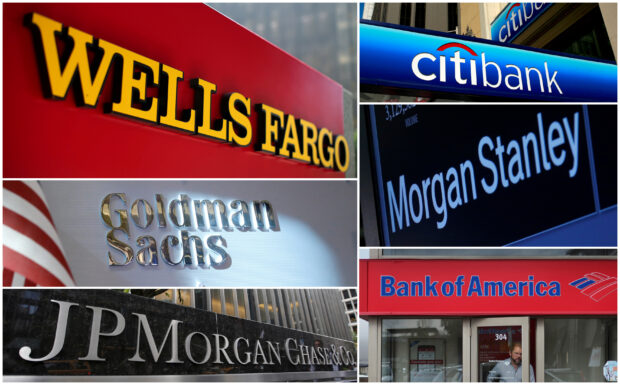US banks’ profits to shrink as they brace for souring loans

A combination file photo shows Wells Fargo, Citigbank, Morgan Stanley, JPMorgan Chase, Bank of America, JPMorgan, and Goldman Sachs from Reuters archive. REUTERS/File Photo
NEW YORK -U.S. banking giants are expected to report lower profits for the fourth quarter after they set money aside to cover souring loans while also paying more to depositors.
The largest banks’ net interest income (NII) – or the difference between what they earn on loans and pay out on deposits – probably fell on average 10 percent in the fourth quarter, Goldman Sachs analysts said. An estimated 15-percent decline in trading revenue will also weigh on earnings, they said.
JPMorgan Chase, Bank of America, Citigroup and Wells Fargo report fourth-quarter and full year results on Friday.
Banks’ profits will likely be squeezed as they set aside more reserves in the fourth quarter to prepare for customers to default on the loans. Profits could also be curbed by banks paying more to keep depositors’ money in their accounts.
Bank of America’s earnings per share (EPS) are expected to drop 23 percent in the fourth quarter versus a year earlier, while EPS at Citigroup and Morgan Stanley will fall 25 percent and 17 percent, respectively, according to analyst estimates compiled by LSEG. EPS is predicted to slide 3 percent for JPMorgan and 2 percent for Goldman Sachs.
By contrast, earnings at Wells Fargo will benefit from a reduction in expenses, including some related to regulatory orders.
Separately, Citigroup investors will look for signs that its sweeping overhaul will raise returns. And Morgan Stanley’s new CEO Ted Pick will provide a strategy update, his first since taking the helm at the start of the year.
The largest banks are also expected to book charges to replenish a Federal Deposit Insurance Corp fund after it was drained by the collapses of Silicon Valley Bank and Signature Bank.
“There is a lot of macroeconomic uncertainty now and it’s hard to predict the trajectory for net interest income,” said Bank of America analyst Ebrahim Poonawala. He cited the debate about the potential pace of Federal Reserve interest rate cuts this year as one of the key questions hanging over markets.
The health of the U.S. consumer is also in focus as lower-income customers fall behind on payments in greater numbers. Although delinquencies are increasing, the strong job market has kept a lid on loan defaults, Poonawala added.
Last year was a strong year for bank profits despite the expected slump in fourth quarter net income. Earnings at the largest banks probably rose 5 percent, compared with a 5-percent decline for regional banks, Poonawala estimated.
The KBW index of banks stocks fell 5.4 percent last year and accumulates a 0.7-percent drop in the first days of 2024.
“I think 2024 will be a transition year, and will set the stage for the resumption of higher loan growth in 2025,” said Jason Goldberg, an analyst at Barclays.
Looking ahead, the slide in NII in the fourth quarter could extend into the first half of this year as banks tighten their lending standards while lower income consumers’ finances become increasingly stretched, Goldman banking analyst Richard Ramsden said.
“We could have the opposite effect on the second half as interest rates go down,” he added.
Banks are expected to conserve capital this year and stay cautious on buying back their own shares as they brace for potentially stricter rules known as the Basel endgame that are open for public comment, analysts said. The upcoming U.S. presidential election could also change the direction of regulation.
Banks had been accumulating paper losses in their portfolios because they held securities that lost value when interest rates rose. As the Fed moves closer to reducing rates, the securities portfolios will regain value, helping to bolster banks’ capital, Goldman’s Ramsden said.